

Introduction: A key goal in prosthodontics is obtaining
an accurate impression. Although stock trays provide
mechanical retention, manufacturers recommend
using tray adhesive with both stock and custom
trays. There is limited research on the adhesive
bond strength between tray adhesives and both
auto- and light-polymerizing custom tray materials.
Manufacturers recommend using adhesive and
impression materials from the same brand, and
there is ongoing debate about the ideal drying time
for tray adhesives before impressions.
Aim: The aim of this study was to do a comparative
evaluation to determine the tensile bond strength
and drying time of different tray adhesives on a
particular vinyl poly siloxane impression material
using two different tray materials.
Materials and Methods: A stainless-steel mold
(15×15×20 mm³) was created according to ADA
specification no. 19. A total of 90 samples were
made, including 45 auto-polymerizing and 45 light
polymerizing resin samples, with surfaces polished
using 120-grit sandpaper. An eye hook was attached to each sample, and cylindrical specimens (15 mm
diameter, 20 mm height) were made from PVC to hold
the impression material. Reprosil (medium-bodied) by
Dentsply was used, along with three tray adhesives:
Dentsply Caulk, 3M VPS, and Extreme by Medicept. A
layer of adhesive was applied to the sample surfaces,
dried for three intervals, and tested for tensile bond
strength using a digital universal testing machine
at 5 mm/min until adhesive failure. Data were then
analyzed statistically.
Results: The mean tensile bond strength ranged from
0.168 MPa to 1.058 MPa. The VLC acrylic resin samples
showed significantly higher bond strength than self
cure acrylic samples across all drying times. Dentsply
Caulk performed best with Reprosil VPS, followed
by 3M VPS and Medicept’s Extreme tray adhesive.
Conclusion: Within the study’s limitations, the
manufacturer-recommended adhesive and impression
material combination gave the best results. It is also
concluded that a drying time of 10-15 minutes is
optimal for VPS tray adhesives.
Key words: tensile bond strength, tray adhesives, vinyl poly siloxane, drying time
A primary goal in prosthodontics is to obtain
an accurate impression, which depends on
factors like tray selection, impression material,
technique, and how the material is retained
in the tray. Various impression materials are
available for different clinical situations, and
achieving a precise marginal fit is essential for
the durability of fixed restorations and the health
of surrounding tissues.1,2
Vinyl poly-siloxane (VPS) is one of the most
widely used non aqueous elastomeric impression
materials in dentistry.3 They offer elastic
recovery, dimensional stability, and excellent
detail reproduction.3,4,5 While stock trays provide
mechanical retention for elastomeric impression
materials, manufacturers recommend using
tray adhesive for both stock and custom trays.
After application, the adhesive is allowed to
dry. However, there is limited information on the
compositions of adhesives used with elastomeric
materials.3 The use of adhesives offer more
accurate and consistent impressions.6,7
The required bond strength between elastomeric
impression material and tray to prevent tearing
during removal is unclear. However, clinical
experience suggests that a strong bond is
essential to avoid undetected errors and prevent
ill-fitting restorations.8,9,10 Custom trays are most
commonly fabricated using auto-polymerizing
and visible light cured acrylic resins. The tray
must be rigid to fully capitalize on the physical
characteristics of the impression material.
The recommended adhesives for silicone
impression materials consist of poly(dimethyl
siloxane) and ethyl silicate. Poly(dimethyl
siloxane) adheres to the silicone impression
material, whereas ethyl silicate generates hydrated silica, creating a physical bond with
the tray material. This results in precise and
consistent impressions. There hasn’t been
much focus on attaching impression materials
to trays made of poly methyl methacrylate
(PMMA) or those cured with visible light. The
majority of tray adhesives are produced by the
same manufacturing company as that of the
impression material.
Data on the bond strength between VLC custom
trays, acrylic resin materials, and VPS impression
materials are inconclusive. One study found
higher bond strengths when using different
VPS materials, but lacked statistical analysis.11
An alternative study found that interchanging
the adhesives amongst two addition silicone
impression materials significantly strengthened
the bond between the tray and impression
material. So, it was concluded that the
manufacturer’s
recommended material
adhesive combination may not necessarily be
the best.12
Reported values for the tensile adhesive bond
strengths of vinyl poly-siloxane(VPS) elastomeric
impression materials range from 0.20 to 2.1 MPa,
depending on the tray or impression material
utilized.6,8,9,10
The optimal drying time for tray adhesives is
unclear, with manufacturers recommending 5
to 20 minutes. Some suggest waiting at least
7 minutes, though results are controversial.10
One author concluded that the bond strength
between the tray adhesive & tray material was
highest 48 hours after application.2 According
to results of an another research, bond strength
was unaffected between 15 minutes and 72
hours drying time once it was applied.13 A study
concluded that Impressions should not be taken
before 15 minutes of drying due to insufficient bond strength.14
The aim of the present study was to determine
the tensile-bond strength and appropriate
drying- time of three different tray-adhesives of
different compositions on a single brand of vinyl
poly-siloxane impression material using methyl
methacrylate auto-polymerizing and visible light
polymerizing tray materials.
This in vitro study was carried out in the
Department of Prosthodontics, K.D. Dental
College & Hospital, Mathura in association with
Spectro Analytical Labs Ltd, Ghaziabad (U.P.)
Sample size estimation: The sample size for
the present study has been estimated using
the software GPower v. 3.1.9.7 [Franz Faul,
Universität Kiel, Germany]
Considering the effect size to be measured (d)
at 60% for Two-tailed Hypotheses, power of the
study at 80% and the alpha error at 5%, the
sample size needed is 60. Thus, each group will
comprise of 45 samples. The samples in each
group will be further sub-divided into 3 sub
groups of 15 samples, allocating 5 samples each
for testing the tensile strength at 3 different time
intervals. [5 samples x 3 times interval x 3 Tray
Adhesives x 2 Resins = 90 samples]
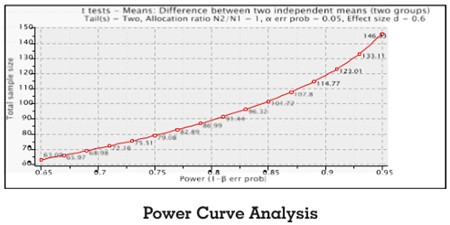
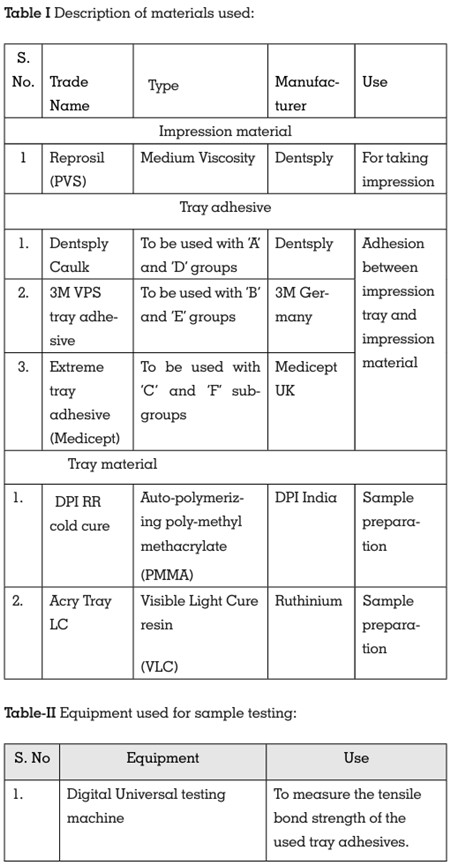

The values those were obtained from the
Universal testing machine while doing tensile
bond strength tests, were noted down and used
as data for the results and statistical analysis.
This study was done in the following manner:
Laboratory methods:
Testing of tensile bond strength of the prepared
samples in the UTM.
Fabrication of the stainless-steel die:
A stainless-steel mold was fabricated (15×15×20
mm³) as per the ADA specification no. 19.
The mold creates a window measuring
(15×15×20 mm³) for preparation of the test
samples. (Fig 5)
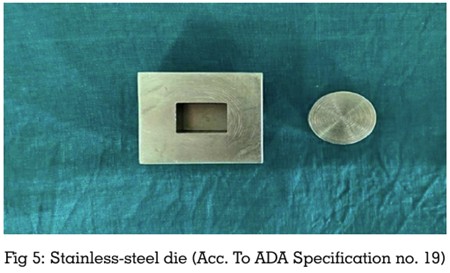
A plate is provided in the upper chamber to
smooth the test sample’s surface, and a screw
in the lower chamber aids in the easy removal of
the fabricated samples.
Preparation of the self-cure acrylic resin
test specimens (45 samples)
A thin layer of Vaseline was applied inside the
die to aid in specimen removal. PMMA resin was mixed in a 3:1 polymer-to-monomer ratio and
poured into the die. After polymerization, the
samples were removed by twisting the screw at
the bottom of the die. Excess resin around the
edges was trimmed with an acrylic trimmer,
and the test surface was polished with 120-grit
sandpaper. A small carbide bur was used to
prepare the area for the eye hook, which was
then secured with self-curing acrylic resin. A
total of 45 cube-shaped samples were made
using these steps. (Fig 6)
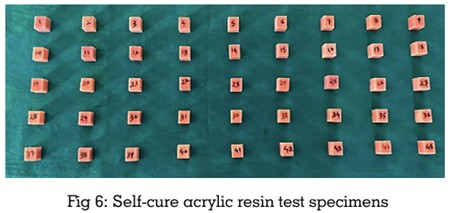
Preparation of VLC resin test specimens
(45 samples)
The VLC resin, in sheet form, was molded to fit
the stainless-steel die. An eye hook was placed
at the center, and the specimen was light-cured
in a UV chamber. After curing, the sample was
removed by rotating the screw at the bottom. A
total of 45 VLC resin samples were prepared
similarly. (Fig 7 & 8))
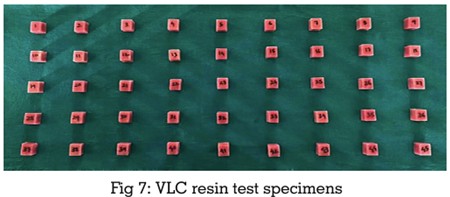
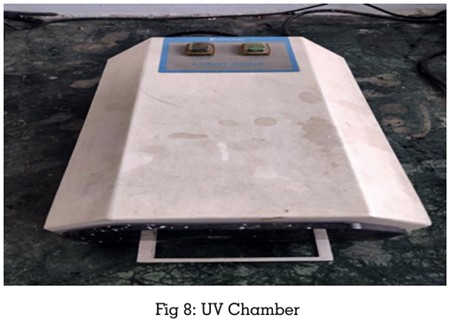
Preparation of PVC pipe open cylinders
for housing of impression material
Cylindrical specimens (15 mm diameter, 20
mm height) were cut from a PVC pipe to hold
the impression material. Five perforations were
made around each cylinder for better retention.
A metal nail was inserted through two centered
holes at the bottom of each cylinder to attach a
hook, providing a second fastening method for
testing at the UTM. (Fig 9)
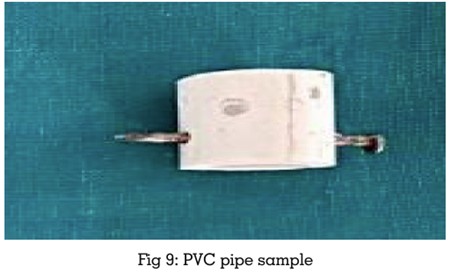
45 samples of PMMA were divided into three
groups (A, B and C) of 15 test samples each,
similarly 45 samples of VLC resin were divided
into three groups (D, E and F) of 15 samples
each.
Each group was then further subdivided into
three subgroups for testing at three different
drying time intervals, i.e. at 5 minutes, 10 minutes
and 15 minutes respectively.
Group A subgroups were named as a, b and c
Group B subgroups were named as d, e and f
Group C subgroups were named as g, h and i
Group D subgroups were named as j, k and l
Group E subgroups were named as m, n and o
And Group F subgroups were named as p, q and r
Testing the samples for tensile bond
strength in the Universal testing machine
Under Group ‘A’, a thin layer of Dentsply Caulk
tray adhesive was applied to the ‘a’ subgroup
test samples according to the manufacturer’s
specifications using a small brush. The samples
were permitted to dry for five minutes. Next, a PVC open cylinder was placed in the center of
the acrylic specimen testing surface in a stone
index and stabilized with rubber bands. After
a five minute drying period, Reprosil medium
bodied impression material from Dentsply
was combined on a glass slab using the base
paste and catalyst paste with a stainless steel
spatula. In order to ensure correct filling without
cavities, the material was then poured into the
cylinder from the bottom until surplus emerged
from the vents. As directed by the manufacturer,
the impression substance was allowed to
polymerize. After curing, the stone index was
removed. The assembly was secured in a
universal testing machine by hooks on the tray
and cylinder ends, preparing it for standardized
mechanical testing.
Tensile bond test at cross head speed of 5
mm/min was conducted till failure of adhesive
separation from the test specimen occurs.
In the similar way ‘b’ and ‘c’ subgroups test
specimens were with a thin layer of Dentsply
caulk tray adhesive and were dried for 10 and
15 minutes respectively before loading into the
universal testing machine for the tensile bond
strength tests. (Fig. 10)
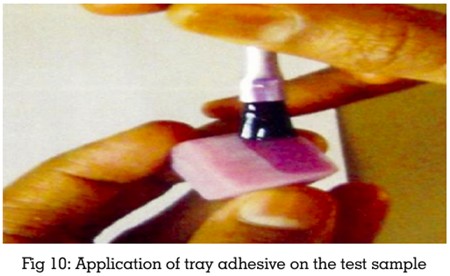
Keeping the impression material same for
all the groups (i.e. Reprosil medium bodied consistency of Dentsply), group ‘B’ specimens
were coated with 3M VPS tray adhesive and ‘d’,
‘e’ and ‘f’ subgroups test specimens were dried
for prescribed drying time respectively before
loading into the UTM. (Fig. 11)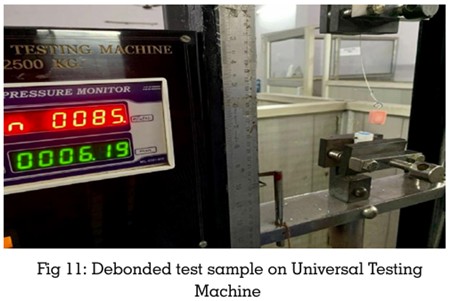 Group ‘C’ Specimens were coated with Extreme
VPS tray adhesive and ‘g’, ‘h’ and ‘i’ subgroups
test specimens were dried for prescribed drying
time respectively before loading into the UTM.
Group ‘C’ Specimens were coated with Extreme
VPS tray adhesive and ‘g’, ‘h’ and ‘i’ subgroups
test specimens were dried for prescribed drying
time respectively before loading into the UTM.
For VLC resin specimens also same
procedures were followed
Group ‘D’ specimens were coated with Dentsply
Caulk tray adhesive and ‘j’, ‘k’ and ‘l’ subgroups
test specimens were dried for prescribed drying
time respectively before loading into the UTM.
Group ‘E’ specimens were coated with 3M VPS
tray adhesive and ‘m’, ‘n’ and ‘o’ subgroups test
specimens were dried for prescribed drying time
respectively before loading into the UTM.
And Group ‘F’ specimens were coated with
Extreme VPS tray adhesive and ‘p’, ‘q’ and
‘r’ subgroups test specimens were dried for
prescribed drying time respectively before
loading into the UTM.
The force was measured in kgF, and the
calculation of tensile bond strength was done
utilizing the formula:
Tensile bond strength = F/A
Here, ‘F’ represents the maximum force causing
separation failure in kgF, A is the area of
adhesion, calculated as the area of the circle
(3.14× r2 in mm², where r denotes the radius of
the circle
i.e., r = [diameter of circle/2], so, r = 15/2 = 7.5
mm
All measurements were recorded in mega
pascals (MPa), and the data underwent analysis.
Statistical Package for Social Sciences [SPSS]
for Windows Version 22.0 released 2013, Armonk,
NY: IBM Corp. was used to perform statistical
analysis of this study.
One-way ANOVA test followed by Tukey’s post
hoc test was used to compare the mean tensile
bond strength between tray adhesives in each
acrylic group at different drying time intervals.
Repeated measures of ANOVA followed by
Bonferroni’s post hoc test was used to compare
the mean tensile bond strength between different
drying time intervals for each tray adhesive and
acrylic material.
The level of significance was set at p<0.05 in
this study.
The mean tensile bond strength ranged from
0.168 MPa to 1.058 MPa. The VLC acrylic resin
samples showed significantly higher bond
strength than self-cure acrylic samples across
all drying times. Dentsply Caulk performed best
with Reprosil VPS, followed by 3M VPS and
Medicept’s Extreme tray adhesive. The mean
tensile bond strength significantly increased
with increase in dry time for different tray
adhesives for both the acrylic groups, however,
no significant changes were observed between
10 and 15 minutes drying time intervals.


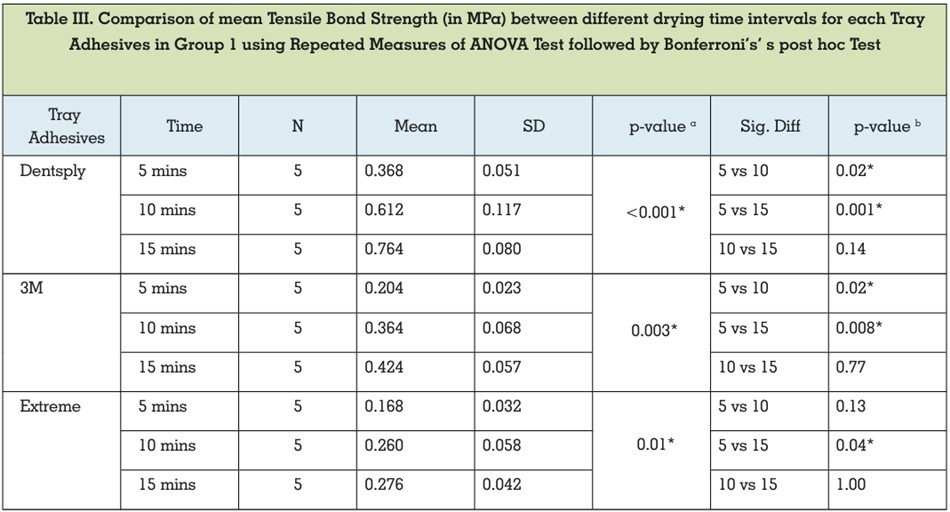
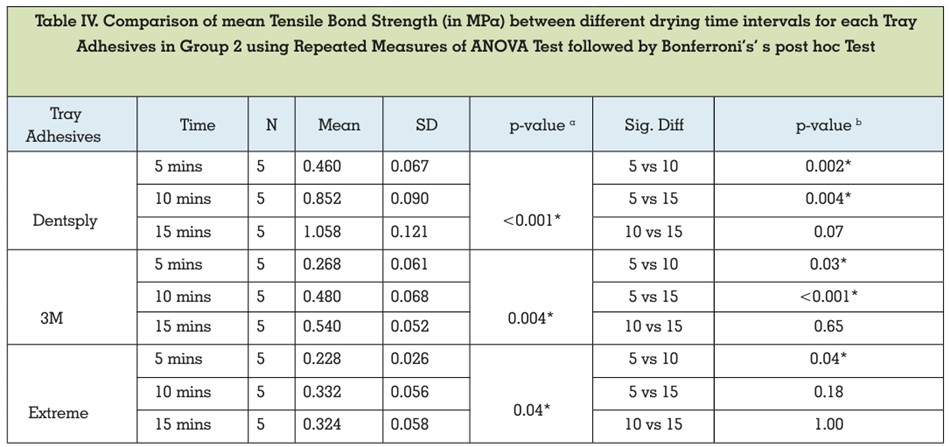
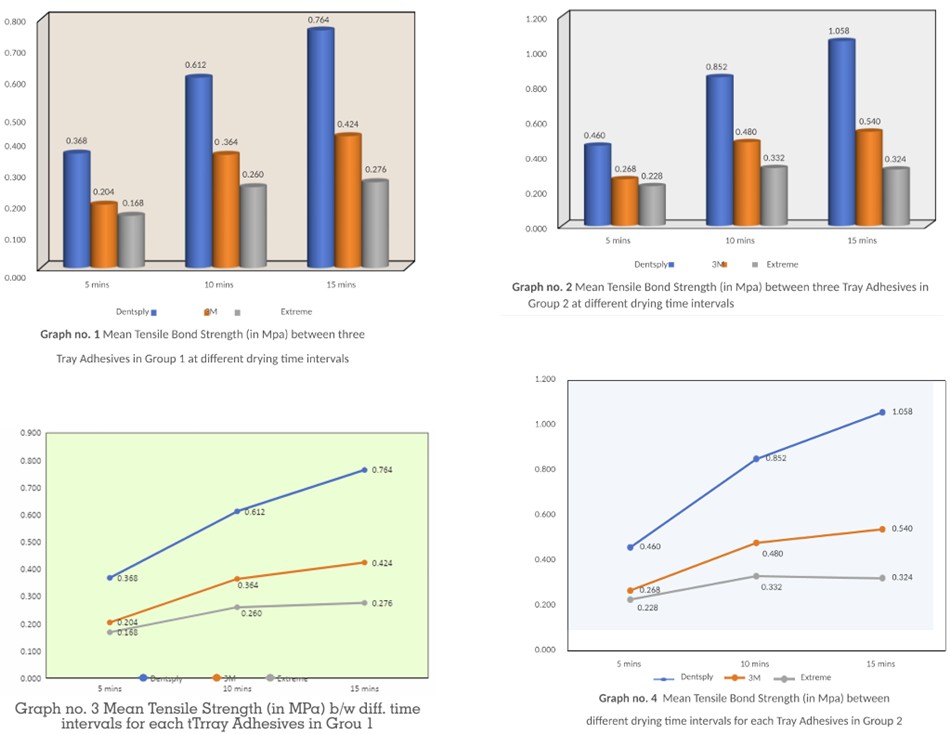
Vinyl poly-siloxane (VPS) is a commonly used
non-aqueous elastomeric impression material
in dentistry, known for its elastic recovery,
dimensional stability, and detail reproduction.
Stock trays provide mechanical retention,
but manufacturers recommend using tray
adhesive with both stock and custom trays to
strengthen the bond and prevent detachment
during removal. Using adhesives ensures more
accurate and consistent impressions, with the
adhesive applied and allowed to dry before use.
Controversial results are reported regarding to the recommended drying time of tray
adhesive after the application. According to the
manufacturers, the drying time for tray adhesives
ranges from 1 to 20 minutes.
A study concluded that the manufacturer’s
recommended material-adhesive combination
may not always be the best, as there’s no clear
threshold for bond strength between impression
materials and trays. Stronger adhesion reduces
the risk of interface failure, which can affect
the
dimensional accuracy of prostheses.
Dental professionals should select compatible
materials to ensure the strongest bond. Davis et al. found that elastomeric adhesive bonding
was insufficient, requiring significant force to
separate the material in undercuts.13
Depending on tray or impression material used,
the tensile adhesive bond strength ranged
between 0.20 to 2.1 MPa for VPS impression
materials.
In the present study, mean tensile bond strength
values ranged between 0.168 MPa-1.058 MPa.
The tray adhesives used in this study had
different compositions from each other. At 5 and
10 minutes drying time, VLC acrylic samples
showed significantly higher tensile bond strength
than self-cure acrylic samples with Dentsply, 3M,
and Extreme tray adhesives. At 15 minutes, VLC
samples had higher bond strength with Dentsply
and 3M adhesives, but no significant difference
was found with Extreme adhesive.
At the 15-minute drying time, Dentsply adhesive
significantly outperformed 3M and Extreme
adhesives in self-cure acrylic samples (P<0.001),
followed by 3M, which showed higher bond
strength than Extreme. In VLC acrylic samples,
there was a significant difference in tensile bond
strength among the three adhesives (P<0.001).
Dentsply Caulk adhesive showed significantly
higher tensile strength than 3M and Extreme
adhesives (P<0.001). 3M adhesive also had
greater tensile strength than Extreme, with a
significant difference (P=0.004).
Similar results were found in various studies
conducted by different researchers. A. Peregrina
et al. found that mean adhesive values ranged
from 0.13 MPa to 1.09 MPa. Most impression
materials showed higher adhesive strength with
VPS adhesive (GC Universal), except for Take I
material, which showed no significant difference
from GC. Spray-on adhesive resulted in lower
bond strength. No differences were found based on tray material for any of the materials or
adhesives tested.3
B.L. Ashwini et al. compared three VPS impression
materials with auto-polymerizing and VLC trays,
using adhesives from GC America, Zhermack,
and a universal adhesive. Adhesive values
ranged from 0.2 to 1.41 MPa. Polyvinyl siloxane
showed stronger bond strength to VLC trays
than acrylic resin, except with 3M ESPE. The
universal adhesive outperformed manufacturer
recommended adhesives. Dixon et al. found
Triad trays had the highest bond strength
compared to Fastray (PMMA).2
Surender Kumar et al. found a significant
interaction between impression materials and
tray adhesives, with no notable effect from
tray materials on tensile strength (p>0.05).
GC adhesive consistently showed the highest
bond strength, and 3M impression material
exhibited the greatest tensile strength. The best
combination was 3M impression material with
GC adhesive.24
The purpose of John A. Payne et al.’s study was
to evaluate the bonding of two thermoplastic tray
resin materials and two non-aqueous imprint
materials. The combinations of Hydrosil imprint
material and Hydrotray resin (smooth) produced
the highest bond strength, 0.797 MPa, in standard
tensile specimens that were manufactured. The
mean tensile bond strength was measured 0.726
MPa in this investigation.11
The tensile bond strength of the addition
reaction silicone used in the Ben E. Grant et al.
investigation ranged from 0.434 MPa to 0.789
MPa. The majority of failures occurred at the
interface between the adhesive and addition
silicone impression material.6
Myong Hee Yi et al. found that the mean
tensile bond strength ranged from 0.12 to 0.47 MPa, consistent with previous research. The
combination of VPS (3M) adhesive with Imprint
II and Silfix-Aquasil significantly increased
bond strength at 10 and 15 minutes, respectively.
Using adhesives and impression materials from
different manufacturers resulted in lower bond
strength than using a combination from the
same manufacturer.22
George E. Cho and colleagues studied the
time-dependent bond strength of two polyvinyl
siloxane impression materials on acrylic resin
disks, using matching adhesives (p<0.05).
Reprosil’s bond strength started at 16.54 lb,
doubled to 33.96 lb at 15 minutes, and reached
42.11 lb after 15 minutes. After 60 minutes, it
remained steady at 42.11 lb, but dropped to
34.62 lb after 8 hours. The bond strength quickly
increased to 15 minutes and then plateaued.10 It
was determined by G. B. Davis et al. that drying
times shorter than fifteen minutes are clinically
unwise due to their inadequacy in strengthening
bonds. In elastomer bond strength to tray
material, no discernible variation was seen for
drying intervals ranging from 15 minutes to
72 hours.13 Catherine M. Leung et al. studied
the effect of drying time on the cleavage bond
strength of irreversible hydrocolloid adhesive.
The bond strength increased from 32 kPa at 1
minute to 37 kPa at 5 minutes, then decreased.
The study concluded that while adhesive
improves the bond strength to stainless steel,
it should not be left to dry for more than five
minutes.19
Based on these studies, the universal tray
adhesive consistently performed better with
various manufacturers’ addition silicone
impression materials. In this study, Reprosil
(Dentsply) showed significantly higher tensile
bond strength with Dentsply Caulk tray adhesive
compared to 3M and Extreme adhesives, with
manufacturer-supplied combinations yielding
better results than different brand adhesives.
A significant increase in mean tensile bond
strength was noted from 5 to 10 minutes, after
which it plateaued at 15 minutes. Earlier studies
suggest that there is no substantial additional
enhancement in tensile bond strength beyond
the 15-minute drying time. Consequently, the
study results indicate that the optimal drying
time for effective outcomes should be within the
range of 10 to 15 minutes.
Clinical Significance
When removing impressions from undercut
areas, separation from the tray can compromise
accuracy. To enhance adhesion and prevent
detachment, various tray adhesives have been
developed. Universal adhesives typically provide
higher tensile bond strength than manufacturer
recommended ones for VPS materials with
auto-polymerizing and VLC resin trays. Using
adhesives and impression materials from the
same manufacturer often gives better results.
Studies show that bond strength rarely increases
beyond 15 minutes of drying, so a 10-15 minute
drying time is recommended for effective results
with VPS materials.
1) The VLC acrylic resin group test samples had
significantly higher tensile bond strength than
the self-cure acrylic test samples when used
with different adhesives at all the three different
drying time intervals.
2) Overall, in both self-cure and VLC acrylic
resin groups the Dentsply Caulk tray adhesive
showed best results with Reprosil medium bodied
consistency VPS impression material (Dentsply)
in comparison to the other tray adhesives used,
followed by 3M VPS tray adhesive and then the
Extreme VPS tray adhesive at different drying
time intervals.
3) The mean tensile bond strength significantly
increased with increase in dry time for different tray adhesives for both the acrylic groups,
however, no significant changes were observed
between 10 and 15 minutes drying time intervals.
4) As per the results of this study, it can be
concluded that the recommended drying time
should be 10-15 minutes for VPS tray adhesives.